Flying with Your Dog: Tips and Tricks
Posted: 09/14/2022 | BY: Erin Cain | Categories: Dog , Top Tips
If you’re planning to fly with a dog, you must prepare for your pup’s travel and transport. There are many things to consider, and it can be tricky to ensure everything goes smoothly. That’s why we’ve put together this list of the best tips for flying with a dog! Follow these guidelines, and your trip will be much easier — and your dog will be much happier, too.
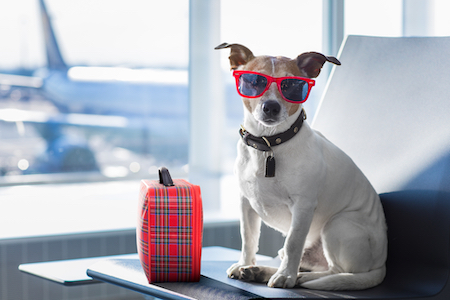
Check with the vet before the flying with your dog.
Make sure your dog is in top shape for air travel by scheduling an appointment with her veterinarian close to the departure date. Every airlines asks for a health certificate from a vet issued within ten days of travel. Sometimes, a fee is associated with obtaining this certificate and may range from $30 – $400. Talk with your veterinarian about what your dog needs and the cost of the health certificate.
The dog parent must obtain this document before the flight, or your dog may not be allowed on the plane. Check the airline’s requirements, so you have the necessary medical information they want for your pup.
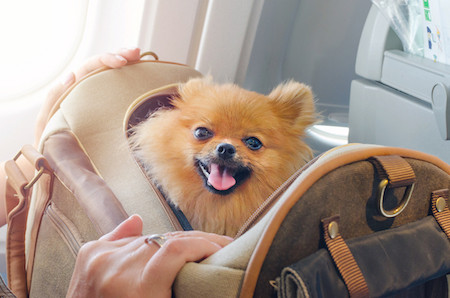
Purchase a quality carrier or crate.
Airlines will often let you bring your pup on board the plane if your small dog is tiny enough to fit in a crate that you can place under a seat. The dimensions of this space may vary depending upon the airline and airplane type. Carefully read all the information regarding the airline’s size policy for pet carriers to fly in-cabin before booking tickets for a trip. Should your trip require connecting flights via different airlines, familiarize yourself with that company’s respective rules about dogs and crates or carriers.
A quality crate or carrier, preferably one that is airline approved, is a must for your dog’s safety during the flight. It should be small enough to qualify as an airline-approved pet carrier but offer enough room for your dog to stand up easily and turn around. The carrier should also have:
- a leak-proof, padded, absorbent bottom
- enough ventilation on at least two sides of the carrier
- strong straps and handles on the sides and top
- a label that clearly states the dog owner’s name, address, phone number, and other important contact information
- a “live animal” sign with arrows marking which way is up.
If your dog is too large for a carry-on carrier or to be considered luggage, you will want a larger crate to keep your pup comfortable in the cargo hold. When your dog is flying in the cargo hold, it’s essential to check in as late as possible to minimize your dog’s waiting time at the airport and in the cargo during the flight. Again, check the airline’s rules ahead of your trip, so you and your pets don’t experience any upsetting surprises.
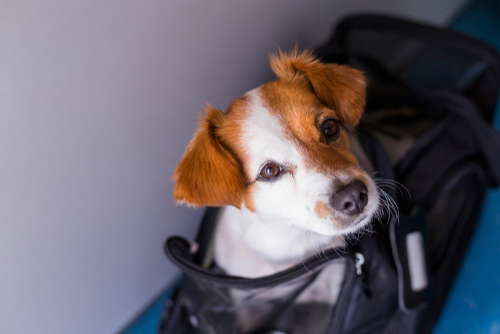
Limit water intake before flying with your dog.
It’s essential to give your dog water before boarding, but don’t give her too much liquid. Many veterinarians recommend feeding an adequate amount of dog food and water once every four hours before landing. Consult with your vet to see what is best for your dog and how long a time frame this may be.
Vets suggest that healthy dogs can control their bladders up until 10 hours, but it’s always best to err on the side of caution and include some form of protection, like pee pads, in the crate. Remember to ask about the airline’s pet relief area so your pup can do her business before you both check in on the plane. Most airlines recommend arriving well before your flight to give your dog time to go to the bathroom.

Avoid drugging your dog.
Dog owners often want to sedate their dogs before a flight so their pups can stay comfortable in a strange and often anxiety-filled environment. While this approach seems to make sense, it is the worst move you can make for your dog. Sedatives prevent dogs from being able to regulate their body temperatures while enduring higher altitudes. This scenario may lead to rising body temperatures and, ultimately, overheating, a life-threatening situation.
Ask your vet about safe, alternative methods to keep your dog calm and relaxed, such as CBD oil or a thunder shirt or security vest.
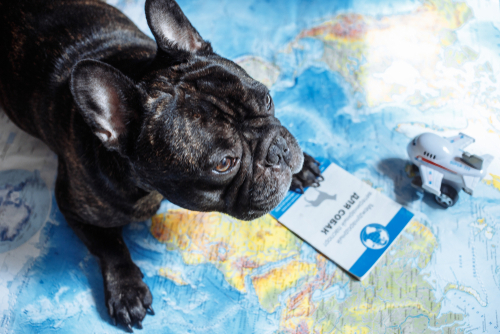
Be aware of breed health restrictions.
Not all dog breeds are allowed to fly due to their breed and associated health conditions. The American Veterinary Medical Association notes that brachycephalic dogs, known as the snub-nosed flat-faced breeds, including French bulldogs and Boston terriers, are typically prohibited from flying. Because of their short snouts and facial construction, these dogs are prone to severe breathing problems. In a flight with suddenly increased altitude pressures, on top of the anxiety, a brachycephalic dog may experience respiratory and cardiovascular problems, overheating, or collapse with potentially fatal results.
Some airlines have also tried to ban bulldogs, like the American Bull Terrier and Staffordshire Terrier. Unfortunately, this ban often extended to dogs resembling bully breeds. The airlines’ concerns stem from fears that these breeds are more dangerous than others and more likely to break out of a carrier or crate. However, in January of 2021, the U.S. Department of Transportation (DOT) ruled that airlines may not discriminate against dog breeds, although these dogs are expected to be formally registered as emotional support animals. That said, some airlines may still give dog owners a hard time if they fly with a bull terrier.
Large breed and heavier dogs may take up too much space or weigh too much in the cargo hold to be allowed on the plane. Additionally, flights for senior dogs, pregnant dogs, or puppies may not be acceptable on certain airlines; puppies must be at least eight weeks old to fly. There are differing guidelines for service dogs. Contact your airline to learn the company’s policies regarding flying with service animals and emotional support animals.
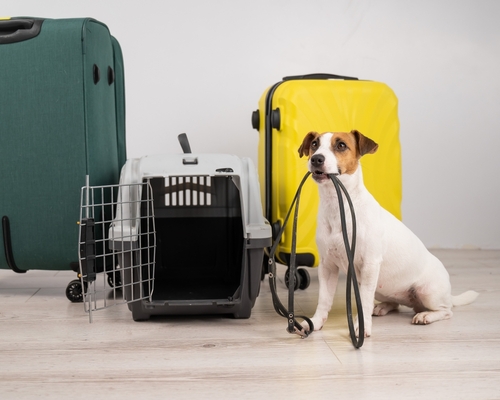
Try for a non-stop flight with appropriate weather conditions.
If possible, find a direct, non-stop flight to limit your dog’s time on hot tarmac and in the air. Plus, you’ll know your dog is definitely on the same plane as you, and you can both avoid the stress and trauma of separation or, worse, a lost or injured pup.
Make sure you account for the weather when flying with your pup. In winter, fly during daylight hours to keep them as comfortable and warm as possible, especially if they are in the cargo hold. Cold temperatures during dusk and evening flights can harm your dog’s health. Try to take early morning or late evening flights for summertime travel to avoid extremely hot cargo holds. Then, your dog is not exposed to more heat and hot temperatures than necessary.
Make flying with your dog safe with a pet insurance plan.
Consider these tips for a safe flight and smooth journey with your dog. For the ultimate protection for your four-legged companion, purchase a pet insurance plan that will provide coverage for your pup in case of an unexpected illness or emergency. You can worry about what’s most important — your furkid — and let the pet insurance provider take care of the bills.
At Pet Insurance Review, we search for the best provider plans for your specific needs and budget. Don’t wait! Get extra protection for your pet with a free quote today.
References:
- Bergenline Animal Hospital. (n.d.). Flying With Your Pet. Retrieved from https://www.northbergenvet.com/health-certificates.pml
- Companion Pet Travel. (n.d.). Cost of Pet Health Certificates for Travel. Retrieved from https://companionpettravel.com/cost-of-pet-health-certificates-for-travel/
- All Paws Express. (2019). What Is The Measurement Guideline For A Pet Carrier? Retrieved from https://allpawsexpress.com/2021/02/28/measurement-guideline-for-a-pet-carrier/
- Abdelrahman, A. L., Maglin, H. (2022). The Best Airline-approved Pet Carriers for Traveling With Your Furry Friend. Retrieved from https://www.travelandleisure.com/style/shopping/best-airline-approved-pet-carriers
- Django. (2022). Is It Safe to Fly Your Pet in Cargo? Retrieved from https://djangobrand.com/blogs/news/is-your-pet-safe-flying-in-cargo
- Pet Friendly Travel. (2022). Animal and Pet Relief Areas at U.S. Airports. Retrieved from https://petfriendlytravel.com/pet-relief-areas-airports-us/
- Starwood Animal Transport. (2021). Don’t Tranquilize Your Pet During Air Travel — There’s Better Options. Retrieved from https://www.starwoodanimaltransport.com/blog/dont-tranquilize-your-pet-during-air-travel-theres-better-options
- Richmond Veterinary Clinic. (2020). Overheating in Dogs. Retrieved from https://www.rvetclinic.com/2020/06/15/mchenry-il-vet-overheating-in-dogs
- AVMA. (2022). Air travel and short-nosed dogs FAQ. Retrieved from https://www.avma.org/resources-tools/pet-owners/petcare/air-travel-and-short-nosed-dogs-faq
- Galang, G. (2022). New Airport Guidelines Remove Dog Breed Bans For Emotional Support Animals. Retrieved from https://dogtime.com/reference/dog-travel/83195-airport-guidelines-remove-esa-breed-bans
- Meyers, H. (2021). How to Prepare for a Puppy’s First Flight. Retrieved from https://www.akc.org/expert-advice/home-living/puppys-first-flight-how-to-prepare/
- U.S. Department of Transportation. (2021). Service Animals. Retrieved from https://www.transportation.gov/individuals/aviation-consumer-protection/service-animals
- Delta Cargo. (n.d.). Temperature Guidelines. Retrieved from https://www.deltacargo.com/Cargo/catalog/temperature-guidelines
The information contained on this blog is intended for informational and educational purposes only and should not be construed as medical advice. It is not a substitute for professional veterinary care. Always consult with your veterinarian before making any changes to your pet's health care or treatment plan.
The authors of this blog are not veterinarians and do not claim to be experts in pet health. The information provided here is based on our own experiences and research, as well as information from reputable sources. However, we cannot guarantee the accuracy or completeness of this information.
We encourage you to do your own research and consult with your veterinarian before making any decisions about your pet's health.
Previous post
Signs of Asthma in DogsNext post
Should You Let Your Dog Kiss You?Compare top pet insurance providers plans.
Enter your dog’s age in years and months to calculate their age equivalent to human years.
Calculate your dog’s ageEnter your cat’s age in years and months to calculate their age equivalent to human years.
Calculate your cat’s age